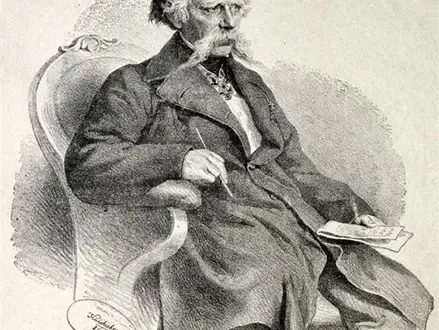Title of Artwork: “Vuk Karadžić, Serbian philologist, linguist and one of the most important reformers of the modern Serbian language”

Artwork by Josef Kriehuber
Year Created 1865
Summary of Vuk Karadžić, Serbian philologist, linguist and one of the most important reformers of the modern Serbian language
As a Serbian philologist and linguist, Vuk Stefanovi Karadzic (Serbian Cyrillic: tujk stefnoyiti Karadzic; November 7th, 1787 – February 7th, 1864) was an important figure in the field of Serbian philology and linguist. He was a key figure in the development of Serbian as we know it now. Encyclopaedia Britannica dubbed him “the father of Serbian folk-literature study” for his work compiling and preserving Serbian folktales. In the newly reformed Serbian language, he also authored the first encyclopaedic dictionary. The New Testament was also translated into a reformed Serbian spelling and language by this scholar.
All About Vuk Karadžić, Serbian philologist, linguist and one of the most important reformers of the modern Serbian language
Internationally, he was well-known, including to Jacob Grimm, Goethe, and historian Leopold von Ranke. For Ranke’s Die serbische Revolution (“The Serbian Revolution”), written in 1829, Karadi was the main source.
He was born in Tri, near Loznica in the Ottoman Empire to a Serbian family of Stefan and Jegda (née Zrni), a Serbian couple (now in Serbia). They moved to Niki from Drobnjaci, where his mother was born (in present-day Montenegro.) For the sake of his own safety, he was named Vuk (wolf) because his family had a low mortality rate for children (the name was traditionally given to strengthen the bearer).
His relative Jevta Savi otri taught Karadzic how to read and write. Karadzic was fortunate to have a relative like this. Karadosi continued his studies in the Tronoa monastery in Loznica, Croatia. To write using an ink solution made from gunpowder instead of conventional pen and ink, the boy was taught calligraphy at the monastery while still a child there.
Without adequate writing paper, his best bet was to use the wrappings from his ink cartridges. His father initially refused to allow him to travel to Austria due to the lack of formal schooling in the region at the time. Because he was unable to concentrate on his studies while living in the monastery, Karadzic’s father decided to bring him back to his family’s farm.
During this time, the First Serbian Uprising against the Ottomans was launched. When Karadzic tried to enrol in Sremski Karlovci’s gymnasium at the age of 19, he was turned away because of his age.
He went for Petrinja, where he studied Latin and German for a few months. Obradovi, a prominent Serbian professor, was in Belgrade at the time and he visited with him to ask for financial support for his studies.. It’s a shame Obradovi didn’t give him any attention at all. Karadzic went for Jadar, where he worked as a scribe for Jakov Nenadovi, after being let down by his boss. Upon the establishment of the Belgrade Higher School, Karadzic was one of its first students.
He soon became ill and had to leave for medical care in Pest and Novi Sad, but he was unable to receive therapy for his leg. Many of Karadzic’s writings referenced the prosthetic pegleg he used in place of his own limb, which he reportedly refused to have amputated in favour of.
In 1810, Karadi returned to Serbia and worked as the secretary to leaders urija and Hajduk-Veljko because he was deemed medically unsuitable for military service.. There were two novels based on his experiences. After the Ottomans’ defeat of the Serbian rebels in 1813, he fled to Vienna and met Jernej Kopitar, an accomplished linguist with a keen interest in secular slavistics. With the support of Kopitar, Karadzic was able to modify the Serbian language and its spelling. In addition, Sava Mrkalj had a major impact on his linguistic work.
Information Citations
En.wikipedia.org, https://en.wikipedia.org/.
























